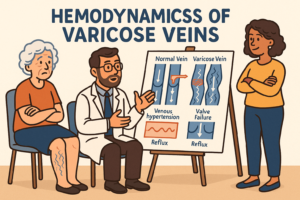Deep venous thrombosis, also known as deep vein thrombosis (DVT), is a serious condition where a blood clot forms in a deep vein, usually in the legs. While DVT can occur for various reasons, prolonged bed rest is a significant risk factor. Understanding the relationship between bed rest and DVT, and knowing how to mitigate the risks, is crucial for anyone who may be bedridden due to illness, surgery, or injury.
What is Deep Vein Thrombosis?
Deep vein thrombosis occurs when a blood clot forms in one of the deep veins of the body, often in the legs. These blood clots can block blood flow, causing pain, swelling, and other symptoms. If the clot breaks free, it can travel to the lungs, leading to a potentially life-threatening condition known as a pulmonary embolism (PE).
Why Does Bed Rest Increase the Risk of DVT?
Bed rest, especially for extended periods, can significantly increase the risk of developing DVT due to several factors:
Reduced Blood Flow: When you are immobile, blood flow in the veins slows down, particularly in the legs. This sluggish blood flow can lead to clot formation.
Increased Blood Clotting: Illness or injury can trigger the body’s clotting mechanisms as part of the healing process. When combined with immobility, this can create an environment where clots are more likely to form.
Dehydration: People on bed rest may not drink as much fluid as they normally would, leading to dehydration. Dehydration can make blood thicker and more prone to clotting.
Compression of Veins: Lying in one position for a long time, especially on your back, can compress veins, particularly in the pelvic region. This compression further reduces blood flow and increases the risk of clot formation.
Other risk factors such as obesity, certain medications, and prolonged immobility can further increase the risk of DVT during bed rest.
Who is Most at Risk? Understanding the Risk Factors
While anyone on prolonged bed rest is at risk for DVT, certain factors can increase this risk even further:
Age: Older adults are more likely to develop DVT due to less efficient circulation and a higher tendency for blood to clot.
Previous DVT or PE: If you’ve had DVT or a pulmonary embolism in the past, your risk is higher.
Obesity: Excess weight can compress veins and reduce blood flow, increasing the likelihood of clot formation.
Pregnancy: Pregnant women, particularly those on bed rest, have an increased risk due to changes in blood flow and clotting during pregnancy.
Certain Medical Conditions: Conditions like cancer, heart disease, clotting disorders, or hormone replacement therapy can increase the risk of DVT.
Recent Surgery: Surgery, especially on the legs, pelvis, or abdomen, combined with post-operative bed rest, can significantly elevate the risk.
Signs and Symptoms of Blood Clots
Knowing the signs and symptoms of DVT is essential for early detection and treatment. Common symptoms include:
Swelling: Swelling in one leg, often starting in the calf, is a common sign.
Pain: A cramping or soreness in the leg, often described as a “charley horse,” may indicate DVT.
Red or Discolored Skin: The skin over the affected area may appear red or have a bluish tint.
Warmth: The affected leg may feel warmer to the touch than the other leg.
If you experience any of these symptoms while on bed rest, it’s crucial to seek medical attention immediately. Additionally, chest pain coupled with difficulty breathing can be a sign of a pulmonary embolism and requires immediate medical attention.
How to Reduce the Risk of DVT During Bed Rest
Fortunately, there are several steps you can take to reduce your risk of developing DVT while on bed rest:
Stay Hydrated: Drink plenty of fluids to keep your blood from becoming too thick. Avoid alcohol and caffeine, as they can contribute to dehydration.
Move as Much as Possible: Even small movements can help keep your blood flowing. Flex your ankles, wiggle your toes, and try to move your legs every hour. If possible, do gentle leg exercises or ask for help with passive leg movements. Movement helps maintain blood flow in the blood vessels, reducing the risk of clot formation.
Compression Stockings: Wearing compression stockings can help improve blood flow in your legs by applying gentle pressure. These are often recommended for people at high risk of DVT.
Medications: In some cases, doctors may prescribe blood thinners (anticoagulants) to prevent clot formation. These medications are particularly important for individuals at high risk.
Elevate Your Legs: Keeping your legs elevated while lying in bed can help promote blood flow and reduce the pressure on your veins.
Physical Therapy: If you’re on bed rest for an extended period, a physical therapist can guide you through exercises and movements that help maintain circulation.
When to Seek Medical Attention
If you develop any signs or symptoms of DVT, such as swelling, pain, or redness in your leg, it’s essential to seek medical attention immediately. Early treatment can prevent the clot from growing or travelling to your lungs, reducing the risk of a pulmonary embolism. Early treatment can also prevent a scenario where a blood clot breaks apart and travels to the lungs, causing a pulmonary embolism.
Conclusion
Prolonged bed rest can significantly increase your risk of developing venous thromboembolism (VTE), which includes deep vein thrombosis (DVT) and can have serious consequences if left untreated. By understanding the risks and taking proactive steps to maintain circulation, you can protect yourself from DVT and stay safe during periods of immobility. Always consult with your healthcare provider if you have concerns about your risk for DVT, especially if you are facing an extended period of bed rest.









